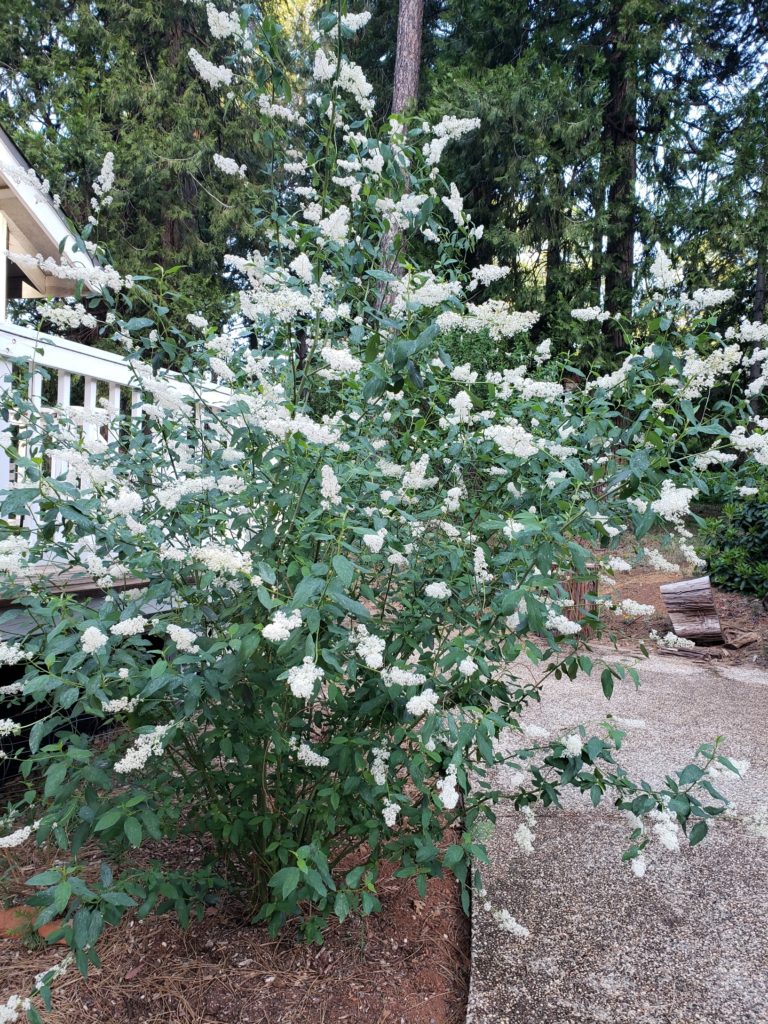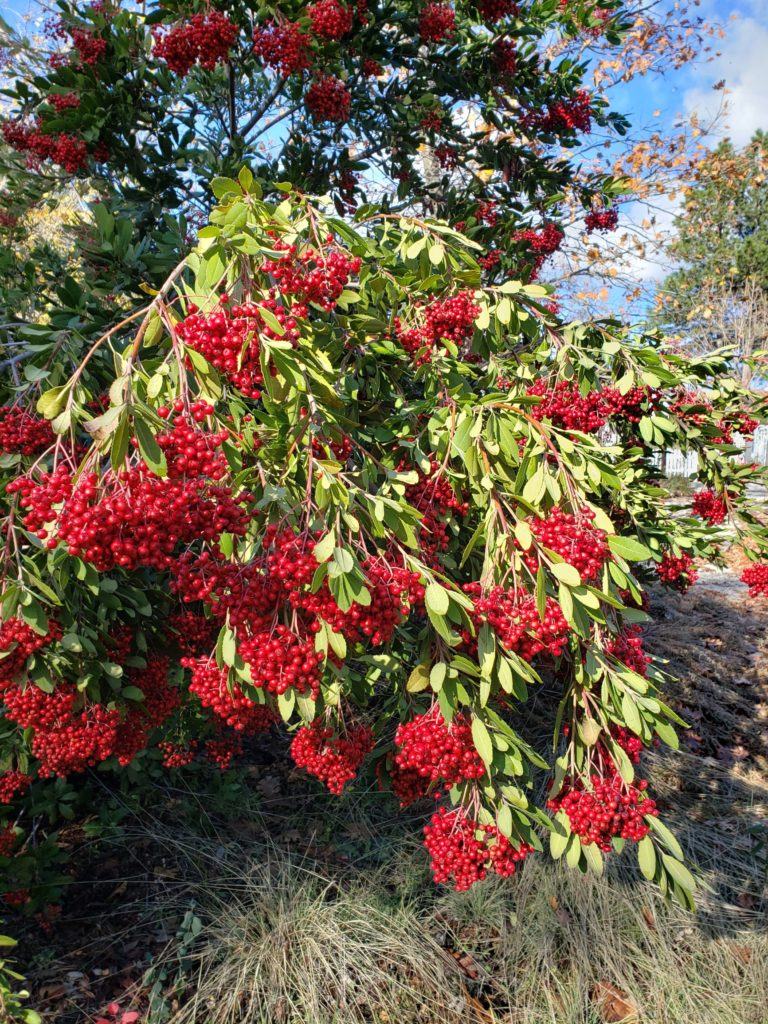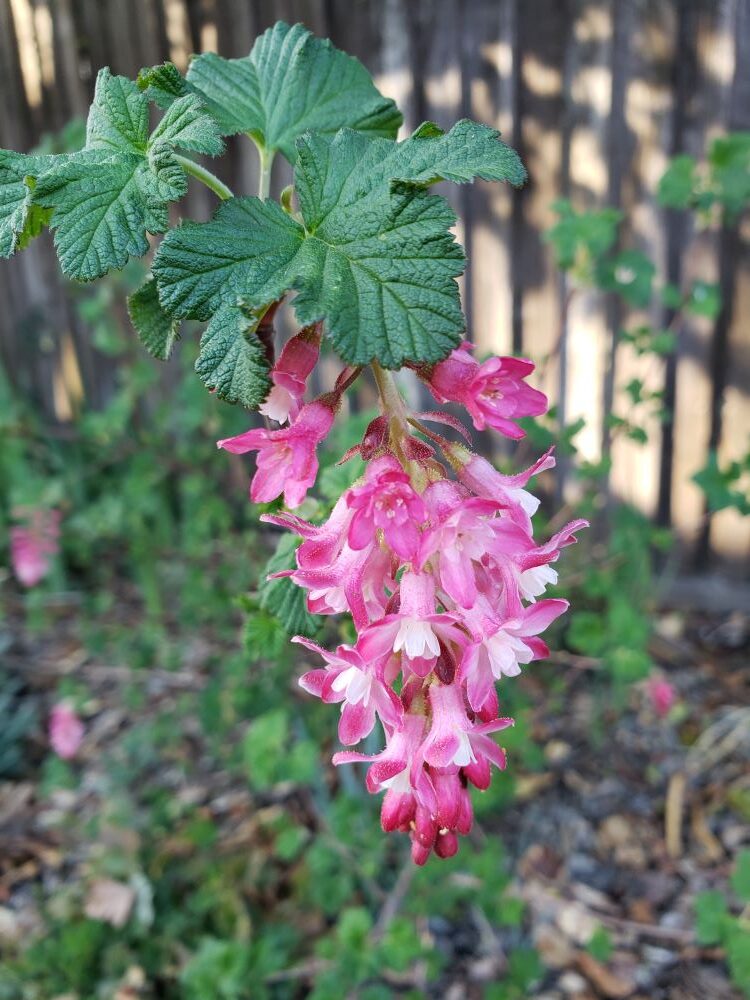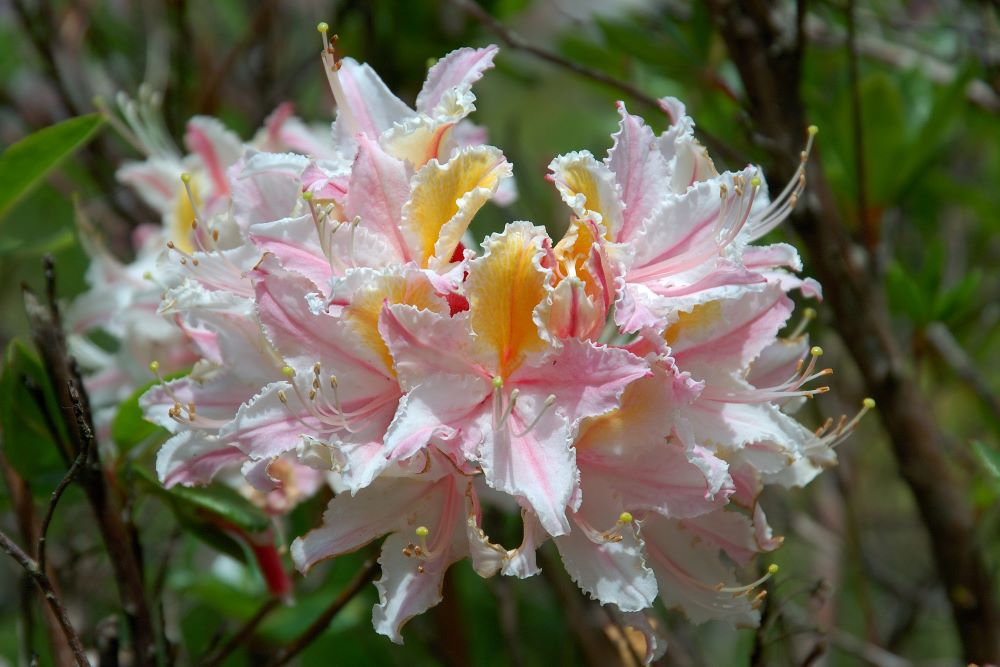Shrubs are perfect to use as hedges, for screening, and for adding more dimension and layering to a landscape.
I’m starting to plan my new landscape makeover and I’m pinpointing the spots that need screening. The worst part is the quaint street light that shines into the bedrooms. I need something evergreen and tall to block that.
Choosing native shrubs for your landscape is a smart thing to do to create a landscape that needs little water, supports pollinators and birds, and gets you in better touch with nature.
They offer a variety of plants that live in our area naturally that many of us have rarely, if ever, seen. Most are deer resistant and many are fire resistant, making them excellent choices for our landscapes.
In our modern world of high wildfire risk, most native plants exhibit some fire resistance and some even have fire retarding qualities.
Many of the commonly used screening plants like Arborvitae, Leyland cypress, Italian cypress, junipers, and bamboo are highly flammable and should not be used at all in high fire risk areas. This is according to the many fire-risk, fire-safe, and fire-resistant plant lists I’ve reviewed.
For hedges, screening, and accent plants, knowing about your native options opens a new palette of plants that make your landscape much more eco-friendly.
Here are eight shrubs to start with
Coffeeberry (Frangula californica)
An evergreen shrub with a moderate growth rate to up to 15 ft. tall and wide that can be pruned to a hedge or to keep shorter. It needs full to part sun and low water. In early summer tiny flowers open feeding many native bees and other pollinators, followed by black berries birds love in fall; foliage feeds several butterflies and moths.

Leaf color varies from deep green to a gray-green. There are cultivars of coffeeberry that achieve higher or lower heights and predictable leaf color. Deer resistant. Known to be somewhat fire retarding.
Deerbrush (Ceanothus integerrimus)
This is a semi-deciduous shrub that grows upright and broad. It has white lilac-like flower clusters with a slight fragrance that bloom in spring. It’s a pollinator magnet in bloom and its foliage feeds several butterflies and moths. It can grow up to over 10 ft. tall and need very little water once established. Needs full sun; may need some deer protection. The roots have a relationship with a soil organism, Frankia, which lets them fix nitrogen in the soil… building soil fertility.
Read more on my page about deerbrush.
Blue Elderberry (Sambucus mexicana)
This wonderful deciduous shrub is found throughout most of California. It can get to 20-30 ft. tall and wide but can be pruned to keep to a smaller size, and is fast-growing. It flowers in spring and summer with umbel shaped clusters, attracting many pollinators and other beneficial insects. Its blue berries feed birds and animals, and can be used by humans, too (if cooked). Deer resistant and needs very little water; does well in full sun or part shade.
Mountain mahogany (Cercocarpus betuloides)
This plant deserves more attention for landscape use. It can be used as a screen, hedged, or even shaped into a small tree. It’s a fast, upright grower to more than 10 ft. tall but can be easily kept narrow, to 6 ft. or less by pruning which makes it a good taller screen for narrow areas. You can use this plant instead if you’re thinking about using bamboo.

It’s evergreen, takes full sun to part shade, and needs very little water.
Tiny white flowers bloom in late winter to early spring and yield showy, feathery seeds that give the plant a glow. It may need some deer protection when young. Like Ceanothus, it has a relationship with a soil organism that lets its roots fix nitrogen into the soil (building soil fertility).
Toyon (Heteromeles arbutifolia)
This is the shrub you spot easily in November to December with big clusters of red berries. They’re especially visible when growing on slopes. Toyon’s an important winter food source for birds. It’s fairly fast growing to 8 ft. or more and can be pruned to a hedge or kept shorter. Takes full sun to shade, but best with some sun. Very low water needs, and is said to be fire retardant, making them perfect for your landscape’s fire safety zone 1 and 2, i.e. out to 70 ft. from the house. Read more on my page about toyon here.
Oregon grape (Berberis aquifolium)
An evergreen shrub that can get up to 7 ft. tall, almost as wide. It’s a coarse, columnar shrub with glossy foliage and leaves with a holly-like prickly edge. The flowers are a showy yellow in spring, attracting native pollinators. The fruits are dark blue, good food for birds. It grows in areas with high shade around here, but it can take full sun and full shade. Needs little to no water when established, but it can take some water in summer.

Oregon grape spreads rhizomes so it can enlarge your planting. It can be sheared for a hedge, too.
Red Flowering Currant (Ribes sanguineum)
This one is not really native here, it’s from coastal California areas. But it’s closely related to our native Ribes, and so showy that I like to recommend it as a near-native plant to use. It’s deciduous, reaches up to 13 ft. tall, starts flowering in late winter with hanging flower clusters of dark pink flowers, flowering over two months. There are varieties available with very dark pink, light pink, or white flowers. Good for bumble bees and hummingbirds, and the currants are loved by birds. Needs a bit of shade here in Nevada County. Deer resistant. Needs a little water here, but fairly drought tolerant. It’s leaves turn a bright yellow in fall. Read my page about red-flowering currant here.
Western Azalea (Rhododendron occidentale)
Our native azalea lives throughout the Sierras and many parts of California mountains. It’s deciduous and can get up to over 10 ft. tall. It’s flowers, white to a light pink, are stunning, and have a slight, pleasant fragrance. It’s food for several butterflies and moths. Needs shade, but enough sun for good flower production, so it’s good with high shade from pines with some sun exposure. Provides nice fall color. Needs some moisture, once a week irrigation, once established.
Get more details on Calscape.org
All California native plants are listed on Calscape.org, where you can get more information on each of these. The fastest way to look a plant up is to google “calscape” name of plant (scientific name is best). You’ll get more details plus photos. However, I hear that the California Native Plant Society is improving the Calscape site to include better photos of the plants in garden use.
How to get the plants
To find these plants to buy, look for the green link that says (number) Nurseries Carry This Plant on the Calscape page (see below). Clicking on the nursery name gives you information for that nursery.

One nursery to look for is Nevada County Native Plants operated by local native plant grower Justin Maciulis. When you find that one give him a call or an email. He maintains his plant list on Facebook.
So far, Toyon is going into my landscape plan to block the street light shining into the house. It’s tall, thick, and evergreen.
If you need help choosing native shrubs for your landscape and placing them with fire-safe spacing, I’d love to help you. Email me at mydelightfulgardens@gmail.com.

